In today’s always-connected world, website performance isn’t just about speed—it’s about reliability. Downtime can be disastrous, leading to lost revenue, damaged customer trust, and missed opportunities. In this post, we’ll explore why minimising downtime should be a top priority and how to ensure your website stays online when it matters most.
Why website downtime matters
Even a few minutes of website downtime can have far-reaching effects, for example 99.9% uptime results in over 8 hours of downtime a year. Whether your site is a hub for e-commerce or a vital source of information, every second of unavailability means:
- Lost sales and revenue: If customers can’t access your site, they can’t buy your products.
- Damage to reputation: Customers trust reliable websites. Frequent outages can lead to frustration and a loss of trust.
- SEO impact: Google rewards reliable websites. Prolonged or frequent downtime can negatively impact your rankings.
Common causes of downtime
Understanding what causes downtime is the first step to preventing it. Some of the most common factors include:
- Server failures: Even the most robust hosting providers can face hardware or software malfunctions.
- Traffic spikes: Unexpected surges in traffic can overwhelm your servers if not managed properly.
- Software bugs: Website updates, third-party plugins, or custom code can introduce vulnerabilities that lead to crashes.
- Cyber attacks: Distributed Denial of Service (DDoS) attacks can bring down your site by flooding it with traffic.
Proactive strategies to minimise downtime
Mitigating downtime starts with a proactive approach. Here are some of the key strategies to ensure your website stays live:
- Choose the right infrastructure
Invest in reliable hosting with a solid uptime record. Consider using cloud-based or distributed hosting for redundancy. - Implement load balancing
Traffic spikes are often unavoidable, especially during promotional events or viral moments. Load balancing distributes traffic across multiple servers, preventing overload. - Use a CDN (Content Delivery Network)
A CDN caches your website content on multiple servers around the world, reducing the load on your main server and improving availability. - Automated monitoring and alerts
Real-time monitoring tools notify you the moment downtime occurs, allowing you to react quickly. Consider setting up automated recovery processes for faster resolutions. - Regular backups and failover systems
In the event of an issue, having backups and automatic failover systems in place ensures your site switches to a backup server with minimal disruption.
Birmingham Airport - migrating to a reliable platform
For Birmingham Airport the reliability of their website is of paramount importance, their passengers depend on real time information, and it is a major revenue source for the airport. They were on a legacy platform and were experiencing substantial downtime due to attacks, and the website generally being unstable.
We migrated the website to Microsoft Azure using a fully virtual app-based architecture alongside Microsoft Frontdoor and Cloudflare to provide a secure and performant infrastructure.
Since moving to the new hosting infrastructure, we have seen a significant impact in performance as show in the following graph:

Key takeaway
Downtime is more than an inconvenience, it’s a threat to your business. Prioritising website performance and implementing strategies to minimise downtime will not only protect your brand but also ensure that you never miss out on an opportunity due to an unreliable site.
At Quba we specialise in creating resilient, high-performance websites designed to handle traffic spikes and minimise downtime. Contact us today to learn how we can help you keep your business online and thriving.
Get more of this by subscribing to our regular newsletter





